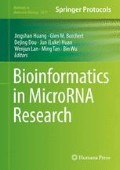Abstract
MiRNA genes (miRNA precursor genes) share some common structural elements with protein genes. As with protein genes, the promoters of miRNA genes are necessary to regulate the expression of miRNA. The computation methods used to find the promoter regions of the protein genes have been applied to miRNA genes and some methods have been designed specifically to find the promoter regions of miRNA genes. The transcription factors (TFs), miRNA, and the targeted genes can form complex regulatory networks in the cells that can be divided into circuits. The miRNA-mediated feed-forward loop (FFL) is the most commonly encountered circuit. The miRNAs can also regulate targeted genes in a collaborative way. Some tools to study these circuits are discussed in this chapter as are some examples of their use.
Access this chapter
Tax calculation will be finalised at checkout
Purchases are for personal use only
References
Krek A, Grün D, Poy MN, Wolf R, Rosenberg L, Epstein EJ, MacMenamin P, da Piedade I, Gunsalus KC, Stoffel M (2005) Combinatorial microRNA target predictions. Nat Genet 37(5):495–500
Rajewsky N (2006) MicroRNA target predictions in animals. Nat Genet 38:S8–S13
Adai A, Johnson C, Mlotshwa S, Archer-Evans S, Manocha V, Vance V, Sundaresan V (2005) Computational prediction of miRNAs in Arabidopsis thaliana. Genome Res 15(1):78–91
Jiang P, Wu H, Wang W, Ma W, Sun X, Lu Z (2007) MiPred: classification of real and pseudo microRNA precursors using random forest prediction model with combined features. Nucleic Acids Res 35(Suppl 2):W339–W344
Qiu C, Wang J, Yao P, Wang E, Cui Q (2010) MicroRNA evolution in a human transcription factor and microRNA regulatory network. BMC Syst Biol 4(1):90
Sengupta D, Bandyopadhyay S (2011) Participation of microRNAs in human interactome: extraction of microRNA–microRNA regulations. Mol Biosyst 7(6):1966–1973
Abeel T, Saeys Y, Bonnet E, Rouzé P, Van de Peer Y (2008) Generic eukaryotic core promoter prediction using structural features of DNA. Genome Res 18(2):310–323
Zhou X, Ruan J, Wang G, Zhang W (2007) Characterization and identification of microRNA core promoters in four model species. PLoS Comput Biol 3(3):e37
Shen-Orr SS, Milo R, Mangan S, Alon U (2002) Network motifs in the transcriptional regulation network of Escherichia coli. Nat Genet 31(1):64–68
Osella M, Bosia C, Corá D, Caselle M (2011) The role of incoherent microRNA-mediated feedforward loops in noise buffering. PLoS Comput Biol 7(3):e1001101
Yan Z, Shah PK, Amin SB, Samur MK, Huang N, Wang X, Misra V, Ji H, Gabuzda D, Li C (2012) Integrative analysis of gene and miRNA expression profiles with transcription factor–miRNA feed-forward loops identifies regulators in human cancers. Nucleic Acids Res 40(17):e135
Hamed M, Spaniol C, Nazarieh M, Helms V (2015) TFmiR: a web server for constructing and analyzing disease-specific transcription factor and miRNA co-regulatory networks. Nucleic Acids Res 43(W1):W283–W288
Friard O, Re A, Taverna D, De Bortoli M, Corá D (2010) CircuitsDB: a database of mixed microRNA/transcription factor feed-forward regulatory circuits in human and mouse. BMC Bioinformatics 11(1):435
Liu J, Ye X, Wu F-X (2013) Characterizing dynamic regulatory programs in mouse lung development and their potential association with tumourigenesis via miRNA-TF-mRNA circuits. BMC Syst Biol 7(Suppl 2):S11
Meng Y, Huang F, Shi Q, Cao J, Chen D, Zhang J, Ni J, Wu P, Chen M (2009) Genome-wide survey of rice microRNAs and microRNA–target pairs in the root of a novel auxin-resistant mutant. Planta 230(5):883–898
Yoon EK, Yang JH, Lim J, Kim SH, Kim S-K, Lee WS (2009) Auxin regulation of the microRNA390-dependent transacting small interfering RNA pathway in Arabidopsis lateral root development. Nucleic Acids Res 38(4):1382–1391
Lu L, Zhou L, Chen EZ, Sun K, Jiang P, Wang L, Su X, Sun H, Wang H (2012) A novel YY1-miR-1 regulatory circuit in skeletal myogenesis revealed by genome-wide prediction of YY1-miRNA network. PLoS One 7(2):e27596
Forrest AR, Kanamori-Katayama M, Tomaru Y, Lassmann T, Ninomiya N, Takahashi Y, de Hoon MJ, Kubosaki A, Kaiho A, Suzuki M (2010) Induction of microRNAs, mir-155, mir-222, mir-424 and mir-503, promotes monocytic differentiation through combinatorial regulation. Leukemia 24(2):460–466
Xu J, Li C-X, Li Y-S, Lv J-Y, Ma Y, Shao T-T, Xu L-D, Wang Y-Y, Du L, Zhang Y-P (2011) MiRNA–miRNA synergistic network: construction via co-regulating functional modules and disease miRNA topological features. Nucleic Acids Res 39(3):825–836
Li Y, Qiu C, Tu J, Geng B, Yang J, Jiang T, Cui Q (2014) HMDD v2. 0: a database for experimentally supported human microRNA and disease associations. Nucleic Acids Res 42(D1):D1070–D1074
Lu M, Zhang Q, Deng M, Miao J, Guo Y, Gao W, Cui Q (2008) An analysis of human microRNA and disease associations. PLoS One 3(10):e3420
Author information
Authors and Affiliations
Corresponding author
Editor information
Editors and Affiliations
Rights and permissions
Copyright information
© 2017 Springer Science+Business Media LLC
About this protocol
Cite this protocol
Hu, Y., Lan, W., Miller, D. (2017). Exploring MicroRNA::Target Regulatory Interactions by Computing Technologies. In: Huang, J., et al. Bioinformatics in MicroRNA Research. Methods in Molecular Biology, vol 1617. Humana Press, New York, NY. https://doi.org/10.1007/978-1-4939-7046-9_9
Download citation
DOI: https://doi.org/10.1007/978-1-4939-7046-9_9
Published:
Publisher Name: Humana Press, New York, NY
Print ISBN: 978-1-4939-7044-5
Online ISBN: 978-1-4939-7046-9
eBook Packages: Springer Protocols

